My best friend Kanth in a scholarly look

My colleague Vengal's sons

VasaV - My friend Lavanya's son
Koustu - My niece

Hi friends. I am AnandaVardhan Chagamreddy. Drawing/Painting is my hobby. I built this blog to make people feel that drawing/painting is not a tough job. I will try my level best to be understandable and sensible. Please give your valuable suggestions to improve my skills and way of presentation.
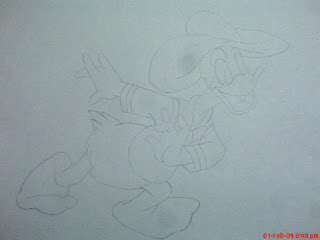 Donald's body will be white in color, but never leave the body with out painting white even if the paper on which you are painting is white. In the below snapshot you will see that I have painted the body of Donald white and shirt with light blue.
Donald's body will be white in color, but never leave the body with out painting white even if the paper on which you are painting is white. In the below snapshot you will see that I have painted the body of Donald white and shirt with light blue. I am going to paint the shirt in 2 different shades. So, I added a tinge of navy blue and white to the light blue I used to paint the cap. Fill the strips near handcuffs and collar neatly with lemon yellow. Paint the legs with light brown as shown below.
I am going to paint the shirt in 2 different shades. So, I added a tinge of navy blue and white to the light blue I used to paint the cap. Fill the strips near handcuffs and collar neatly with lemon yellow. Paint the legs with light brown as shown below.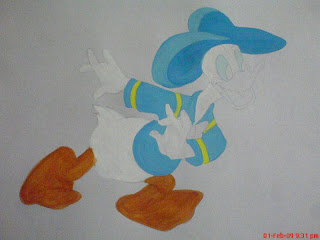 Oops! I painted the legs too dark. I added 3 brown + 1 white and painted the legs again to make it lighter. The beak is also painted in the same color. The bow tie and tongue are painted in red.
Oops! I painted the legs too dark. I added 3 brown + 1 white and painted the legs again to make it lighter. The beak is also painted in the same color. The bow tie and tongue are painted in red.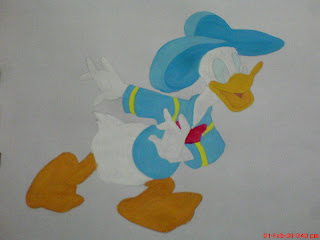 Now lets paint the background; the easiest part. Its your wish to create your own background. I have done it like this...
Now lets paint the background; the easiest part. Its your wish to create your own background. I have done it like this...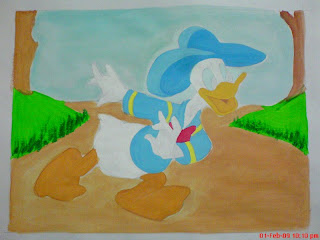 The last and most important part is to draw outlines. It brings a lot of change and grace to the picture. The final one looks like this...
The last and most important part is to draw outlines. It brings a lot of change and grace to the picture. The final one looks like this...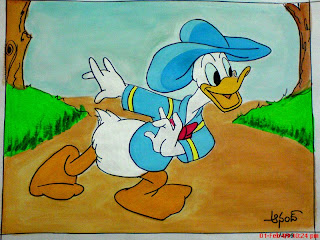 The drawings I make have no comparison to the master piece the legend had created. So, I keep on practicing ;-)
The drawings I make have no comparison to the master piece the legend had created. So, I keep on practicing ;-)
 Next comes the beak, draw simple connecting curved lines as shown below to complete the upper part of beak.
Next comes the beak, draw simple connecting curved lines as shown below to complete the upper part of beak. and then...
and then... Simple! right? Now let us complete the lower part...
Simple! right? Now let us complete the lower part... Now, lets draw the eyebrows and the head part...
Now, lets draw the eyebrows and the head part... Next comes the cap and little touchup completes Donald's face...
Next comes the cap and little touchup completes Donald's face... It comes out really well on a paper. Next post will be on how to draw a full picture of Donald and paint it.
It comes out really well on a paper. Next post will be on how to draw a full picture of Donald and paint it.

 Next comes shading and smudging. Imagine light coming from one direction while shading the picture. Say, if the light is falling from right, left outlines should be shaded darker than the right ones. Once the shading is done, take a small clean paper, fold it in triangular shape and some extra paper to hold (The sharp edges of the paper helps to smudge smaller areas of the picture).
Next comes shading and smudging. Imagine light coming from one direction while shading the picture. Say, if the light is falling from right, left outlines should be shaded darker than the right ones. Once the shading is done, take a small clean paper, fold it in triangular shape and some extra paper to hold (The sharp edges of the paper helps to smudge smaller areas of the picture). Though I have managed to draw the girl's picture it didn't really match her original beauty.
Though I have managed to draw the girl's picture it didn't really match her original beauty.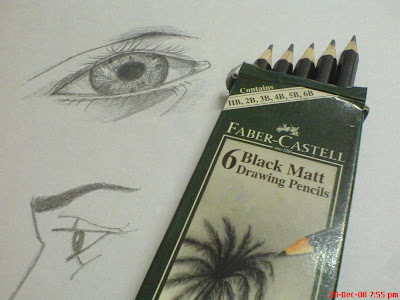
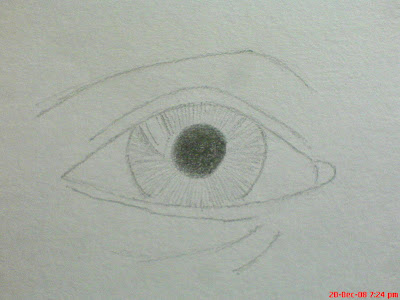
 How to start?
How to start?